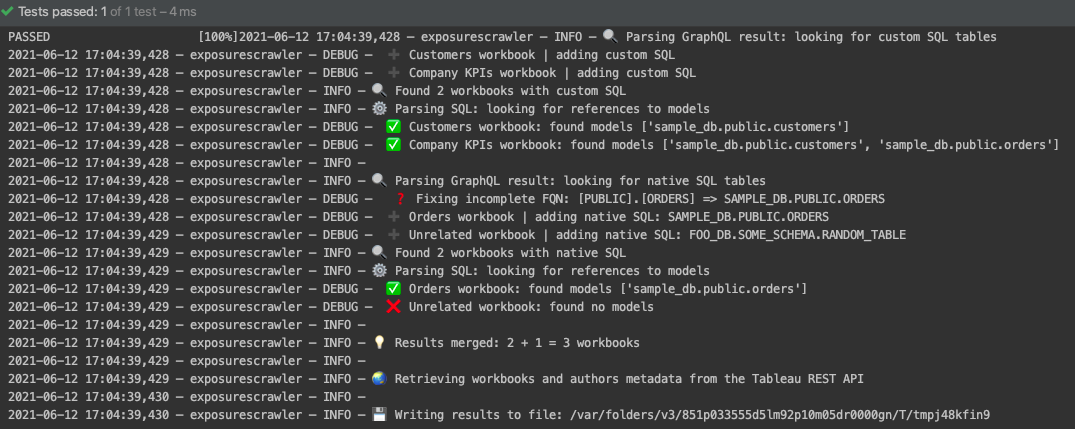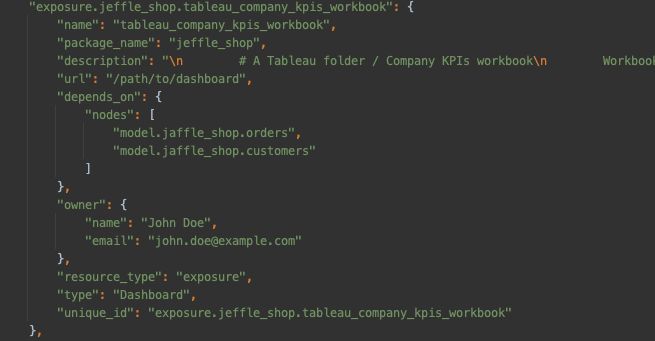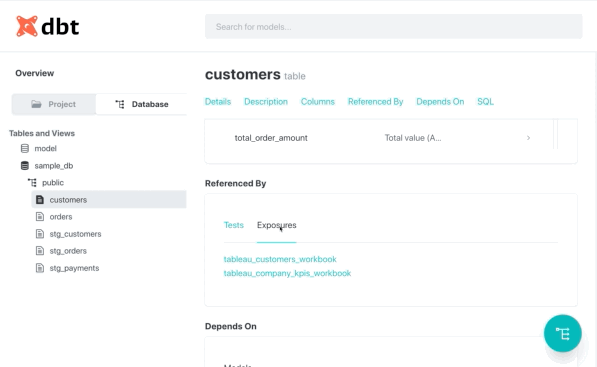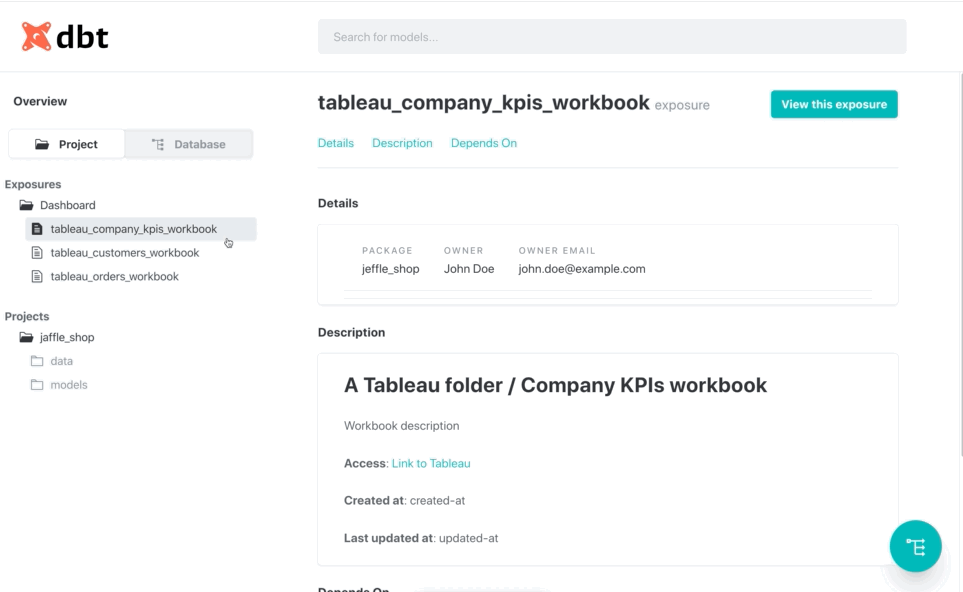Extracts information from different systems and convert them to dbt exposures
Project description
dbt exposures crawler
Automates the creation of dbt exposures from different sources. Currently, only Tableau workbooks using Snowflake SQL are supported as a source.
This project is in an ALPHA stage. Internal and external APIs might change between minor versions.
Please reach out if you try this at your own organization. Feedback is very appreciated, and we would love to hear if you had any issues setting this up at your own.
Motivation
dbt is an open-source tool to manage data transformations in SQL. It automatically generates
a documentation portal from your project which includes a dependency lineage graph. It is possible to add external
downstream dependencies to this graph (such as a dashboard on a Business Intelligence tool) through a dbt feature called
exposures, which are normally defined through yaml
files.
This project automates the creation of exposures by implementing crawlers to parse the metadata of downstream tools. Currently, only Tableau dashboards are supported, but we have plans to include Metabase as well.
A few use cases on how having exposures can help:
- analysts working on a model can use the exposures to perform impact analysis and see which reports might be impacted by their changes;
- report consumers can find their report on dbt and see which models are used and read their documentation;
- report consumers can find which other reports are using the same models as their favorite reports.
How it works
Summary:
- Retrieve dbt models and sources from
manifest.json; - Extract metadata (custom SQL and table references) from Tableau workbooks using their GraphQL API);
- Try to find occurrences from the dbt models and sources in the Tableau SQL;
- Use the Tableau REST API to retrieve additional information about the workbooks (author, project, etc);
- Create the dbt exposures (in-memory) and write it back to the
manifest.json.
More in-depth explanation:
First, you must provide the path to a dbt project manifest. The metadata and fully qualified names (database, schema and object name) are extracted from all dbt models and sources represented in the manifest. The combination of dbt models and dbt sources will from now on be referred as dbt nodes.
Next, workbook metadata is extracted from Tableau using their Metadata API, including workbooks that use custom SQL queries and workbooks that don't (which are referred in this project as "native SQL" workbooks). Note that this API is included in all Tableau licenses (i.e. it does not require the Data Management Add-on), but must be manually enabled if you host your own Tableau Server.
The SQL from the custom SQL workbooks and the table names from the native SQL workbooks are normalized through simple heuristics, such as removing quotes and converting the custom SQL to lowercase. Now that both normalized SQL and normalized table names from Tableau, and the fully qualified names for the dbt nodes are available, the project tries to find the occurrences of the latter in the former.
The result of the above is a mapping of workbooks and which dbt nodes they depend on. For every workbook (with mapped dependencies available), extra metadata that was not available in the Metadata API is then retrieved from Tableau by using their REST API, including when the workbook was created, when it was last updated, to which folder it belongs on Tableau and information about the author of the workbook.
As a final step, the information above is written back in the provided manifest.json in the form of exposures. Note
that instead of generating .yaml files for each exposure, they are written directly on the manifest.json.
Example
To better understand how the project works, let's take as an example
the jaffle_shop dbt sample project. It has, among other models,
a customers and an orders model.
Now suppose that you company has 4 workbooks on Tableau:
- Customers workbook: accesses the
customersdbt model through custom SQL; - Company KPIs workbook: accesses both models through custom SQL;
- Orders workbook: accesses the
ordersmodel without custom SQL; - Unrelated workbook: a workbook that does not use the dbt project but instead has a static data source.
When running this project, you would get the following console output:
The manifest.json that you provided would have 3 new exposures added to it, such as:
Those exposures can then be visualized through your dbt documentation portal, either by finding which exposures are downstream dependencies of a certain model:
Or by doing the inverse. Starting from an exposure, find which models are used on it:
This example has been taken from the integration tests available in this project. You can read more in the Testing
section below.
Assumptions and limitations
- Only custom SQL written on Tableau workbooks using fully qualified names (
DATABASE.SCHEMA.OBJECT) will be detected; - For now, only Tableau workbooks (and not published data sources) are supported. Also, only Snowflake SQL is currently supported.
Installation
This project requires Python 3.9+. It has only been tested with dbt 0.19, Tableau Server 2021.1 and Snowflake SQL dialect.
Over the coming weeks we will have it published on PyPI and you will be able to install it by:
$ pip install dbt-exposures-crawler
Usage
Internally, we use this automation as part of our dbt docs release pipeline. We have a GitHub Action that does the following:
- Clone our dbt repository;
- Install dbt and our dependencies;
- Run
dbt docs generate(remember to run it against your production environment); - Run this project (using the
manifest.jsongenerated from the previous command as input); - Publish the generated documentation portal;
To run this project, we use:
python3 -m exposurescrawler.crawlers.tableau \
--manifest-path=~path/to/dbt/target/manifest.json \
--ignore-projects Archive \
--verbose
Make sure you check the .env.example file to see which environment variables must be defined.
Development
Clone the repository and install it in editable mode:
$ pip install -e .
Before opening a pull request, make sure you run:
make lint: runsmypy,blackandflake8;make test: runs all tests
Architecture
The entry point for the crawlers should be on the crawlers module. For now, only Tableau is supported.
The tableau module contains all API clients (REST and GraphQL) and models.
The dbt module contains a model for representing a dbt exposure and utilities for parsing, interacting and saving dbt
manifests.
Finally, the utils module has functions for logging and string parsing.
Testing
For the integration tests, we use a sample manifest.json as a fixture. It was manually generated from
the jaffle_shop, an official dbt sample project.
$ git clone https://github.com/fishtown-analytics/jaffle_shop
$ cd jaffle_shop
$ pipenv shell
$ pip install dbt==0.19.1
After adding an entry on my dbt profile and then setting the default database on the project to sample_dbt on
the dbt_project.yaml:
$ dbt compile --target prod
The generated manifest.json is then prettified and copied to the tests/_fixtures folder. I've also manually removed
the macros entries from the file just to make it easier to navigate through it in case of troubleshooting.
$ cat target/manifest.json | jq > $PROJECT_ROOT/tests/_fixtures/manifest.json
Future ideas
- Allow filters to be passed. E.g. only include Tableau workbooks with certain tags;
- Add support to Tableau published data sources;
- Include other BI tools to be crawled, such as Metabase.
Contributing
We are open and would love to have contributions, both in Pull Requests but also in ideas and feedback. Don't hesitate to create an Issue on this repository if you are trying this project in your organization or have anything to share.
License
This project is licensed under the Apache License, Version 2.0: http://www.apache.org/licenses/LICENSE-2.0.
Project details
Download files
Download the file for your platform. If you're not sure which to choose, learn more about installing packages.
Source Distribution
Built Distribution
Hashes for dbt-exposures-crawler-0.1.1.tar.gz
| Algorithm | Hash digest | |
|---|---|---|
| SHA256 | 66b7c1501030cdfbf5aeeb8d7e4fc186ad724c55d2294aa692a12071990a22f6 |
|
| MD5 | fca1b74fced7bef231cfee38f4c58e27 |
|
| BLAKE2b-256 | 69066f6d706da62629aa7063fff9e870405e10b7d8e4ade9647d853c9ba55ec3 |
Hashes for dbt_exposures_crawler-0.1.1-py3-none-any.whl
| Algorithm | Hash digest | |
|---|---|---|
| SHA256 | 2dbd5532743bbea927a33a0b23a69d5690d7ae8a0e4b488f9ed4ff242b0d9f72 |
|
| MD5 | 79aa2254366ca73bcaaa2b22ba8ff4ee |
|
| BLAKE2b-256 | 720a01781675f54ef339c61ed7a19da246fcc21accd87f9721637d154420c324 |




















